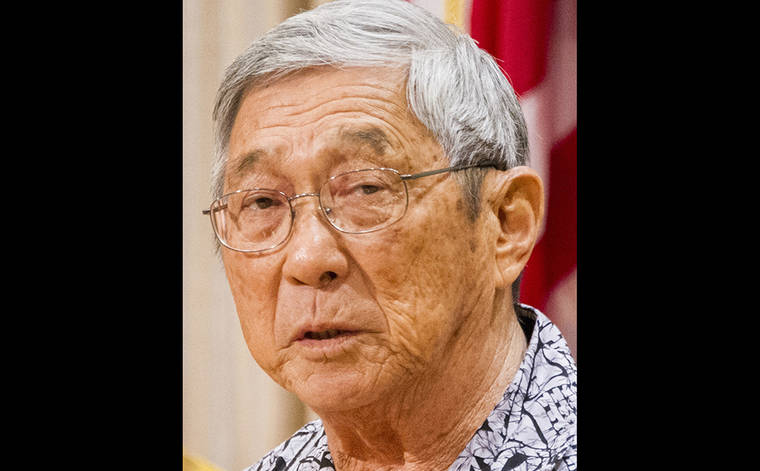Outgoing Mayor Harry Kim wants the state to re-evaluate the effectiveness of the Safe Travels Hawaii program as the mayor of Kauai pushes to remove that island from the program entirely.
Kauai Mayor Derek Kawakami sent Gov. David Ige a request Tuesday asking to exclude Kauai from participation in the Safe Travels program, which allows travelers to skip an otherwise mandatory 14-day quarantine upon arrival with the presentation of a negative COVID-19 test taken within 72 hours of arrival.
Kauai, which reported three new COVID-19 cases throughout the entire month of September, has seen a significant spike in cases since the middle of October, when the Safe Travels program went into effect.
Kim said Wednesday that he has made no secret of his belief that the Safe Travels program has always been insufficient to prevent the spread of COVID-19 in Hawaii.
“The health experts said from the beginning that just one test wasn’t enough,” Kim said. “We’re the only county with a second test, which is the only way to make sure that (travelers) weren’t asymptomatic during the first test.”
The Big Island is the only county in the state to require a second, post-flight negative COVID test for travelers seeking to avoid quarantine. Kim said the decision to implement the second test was necessary to avoid what he identified as several “loopholes” in the Safe Travels program.
For one thing, Kim said, nearly one-quarter of all travelers to and within the state are exempt from the program entirely, meaning they do not have to get tested at all, which creates a large gap in the state’s ability to gather data on the virus’ spread.
Kim said he strongly urged Ige to remove all exemptions from the Safe Travels program and require all travelers, essential or otherwise, to be tested.
Kim also said that he requested that Ige immediately begin an evaluation of data collected by the Safe Travels program and the Big Island’s post-flight testing program to determine how successful they have truly been at limiting the spread of the virus.
A few hours after Kim’s comments to the Tribune-Herald, the state Department of Defense announced that Safe Travels Hawaii has detected 45 positive COVID-19 cases in the 20,253 tests conducted since its launch Oct. 19, and that Wednesday marked the end of the program’s “data collection phase.” The program now proceeds to its assessment phase, according to the announcement.
“We are very pleased with the surveillance study and it has extreme merit in assessing the Safe Travels Hawaii pre-travel testing program,” said Lt. Gov. Josh Green in a statement. “We look forward to delivering a completed report to our state and county leadership so they can make data-based decisions on the best way to move the program forward and manage Hawaii’s COVID-19 response.”
While data analysis results are extremely preliminary, they apparently imply that returning residents are more likely to contract COVID-19 compared to visitors, although the Department of Defense did not speculate as to why that might be the case.
“Conducting an antigen test upon arrival, with a subsequent confirmatory PCR test, as Hawaii County has done, has proven to be helpful,” Green said. “To the extent mayors can follow a similar policy and operationalize post-testing, I recommend that course of action for extra assurance and an added layer of safety to the Safe Travels pre-travel testing program.”
Kim said he is confident in the county’s post-flight testing program and has requested the state give the program more space at Ellison Onizuka Kona International Airport in order to resume full testing — currently, because of space limitations, only 25% of arriving travelers in Kona are being tested.
However, some members of the health community do not think that even the second tests are sufficient.
Oahu physician Darragh O’Carroll wrote, in an article co-signed by 10 other Hawaii doctors, that post-flight antigen tests — the same tests conducted by Hawaii County — are unlikely to catch travelers at an early stage of their infection.
People infected with COVID-19 do not shed the virus immediately, O’Carroll explained, meaning that, while they are infected, they are not immediately contagious.
However, during this phase, their infection is also undetectable by any available COVID-19 test, meaning a traveler in this stage of infection could appear safe in their pre-flight test, but infect members of the community after arriving in Hawaii.
“Our pacific neighbor, the Commonwealth of the Northern Mariana Islands, requires an entry test and a second test after 5 days of quarantine,” O’Carroll wrote. “According to data released on August 18th, 40 out of 4,007 travelers that arrived were found to be positive for coronavirus, that’s 1 in 100. However, the entry test only caught 31 percent of them, and the rest tested positive on day 5.”
Instead, O’Carroll argued, surveillance tests — a series of tests taken throughout the course of several days — would be more effective at finding positive cases, but Kim admitted that administering such tests would be extremely difficult.
More than 800 members of the Hawaii health care industry signed a letter to Ige in October expressing grave concerns about the safety of reopening travel to the state with only a single-test screening program.
Meanwhile, a peer-reviewed paper by a University of Washington researcher suggests a model used by Hawaii to estimate that fewer than one in 1,000 travelers would pass a single-test screening by being asymptomatic was egregiously flawed.
In particular, the researcher argued, Hawaii’s model underestimated the prevalence of COVID-positive people among the community.
Email Michael Brestovansky at mbrestovnasky@hawaiitribune-herald.com.






